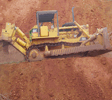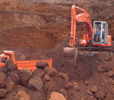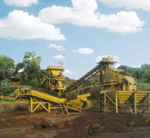


Exploration and Drilling
 |
 |
 |
Conventional and unconventional boreholes
are drilled by pitting and trenching within the mining leasehold areas.
They are drilled on a grid pattern of 200 x 200 meters to locate the
ore body. The grid maybe tightened for a detailed assessment and quality
control. Bore holes are made to a minimum of 60 meters but if the ore
body persists, they will be drilled through the entire thickness. The
core of the bore hole is systematically stored in wooden boxes, logged
and sampled for every 1.5meters and sent for detailed chemical analysis.
Ripping / Dozing
and excavation
 |
 |
 |
The Mining operations are done by the open
cast methods. Rippers and Dozers are used to loosen the hard laterite
cover which is treated as reject. The loosened reject material is then
loaded using hydraulic excavators and transported using tipper trucks
to the waste/rejection dump which are maintained outside the mineralized
zone. Excavators and trucks are then used to mine the crude ore and
transport it to the processing plants. If the ore body is situated below
the ground water level, pumps are used to lower the water table.
Focus on the
Environment
 |
 |
 |
The entire
mining activity is done in an eco friendly manner in an effort to ensure
socioeconomic growth. For example, rain and ground water collected in
the mining pit is continuously discharged to a setting pond where it
gets purified and overflows into a trench having filter beds. The clean
water flows from a trench through a nearby water course. Water is regularly
sprayed on the mine roads and also on the rejection dump to suppress
dust particles. In addition, air quality, water quality as well as sound
levels are continuously monitored all round the year in accordance with
statutory norms. The rejection dumps are capped with laterite before
the monsoons in order to avoid erosion and contamination of rain water
from the dumps.The rejection dumps present a blot on the landscape if
left unprotected, washouts are likely to arise in the monsoons posing
a pollution hazard to the surrounding areas. In order to offset the
ill effects, preventive measures have been resorted to, in order to
propagate vegetation. We plant various species of trees, usually the
local varieties, which have a high survival rate and take root very
quickly. We have also transplant local varieties which are found in
the nearby areas such as, cumbio, Sanvor, Billomaoo, marott, Jamun,
Bibo, Ambaddo, Kinal, Nanno and cashew.
| About us |
| Shipping |
| Product Range |
| Beneficiation |
| Quality Control |
| Shipping |
| Ship Broking |
| International Trading |
| Other Activities |


